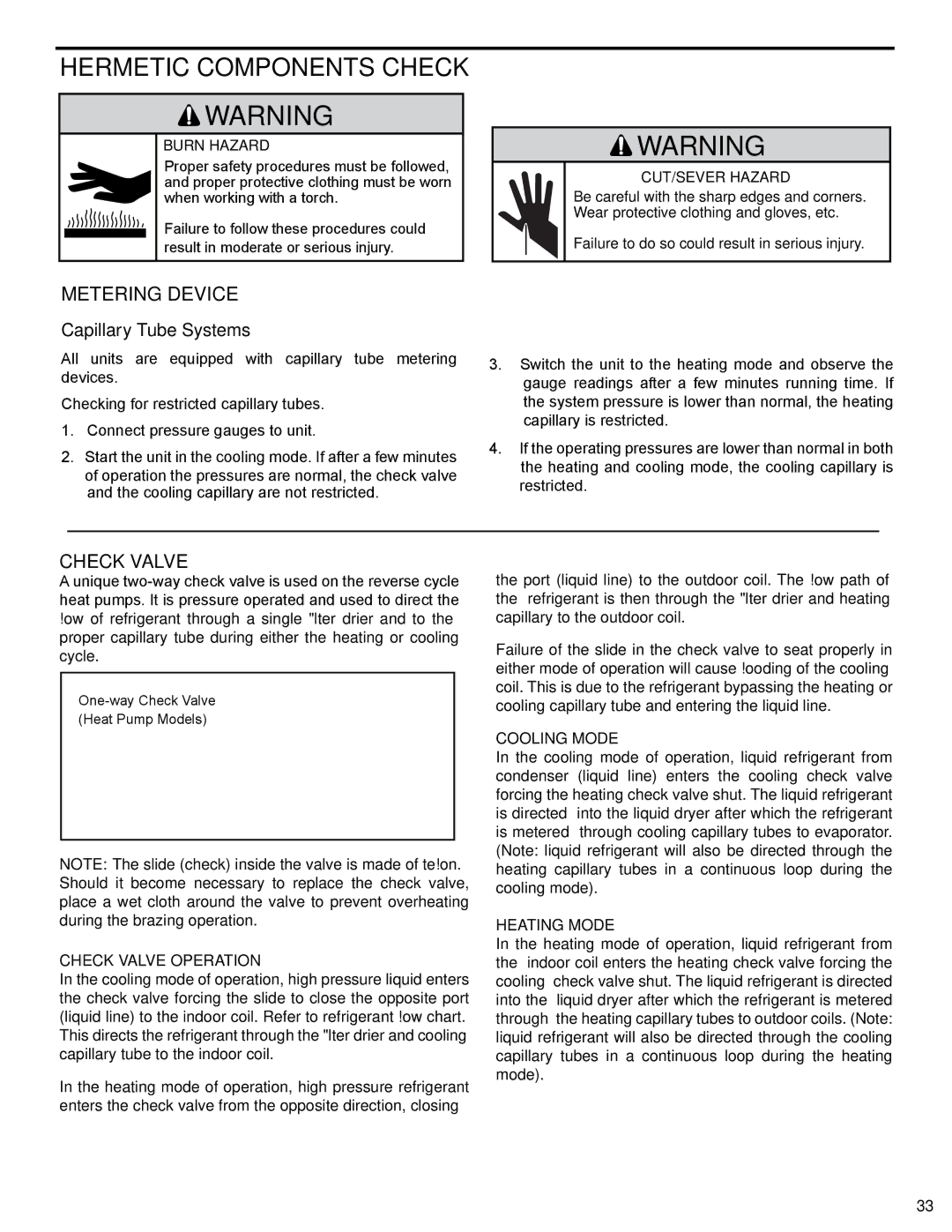
HERMETIC COMPONENTS CHECK
![]() WARNING
WARNING
BURN HAZARD
Proper safety procedures must be followed, and proper protective clothing must be worn when working with a torch.
Failure to follow these procedures could result in moderate or serious injury.
![]() WARNING
WARNING
CUT/SEVER HAZARD
Be careful with the sharp edges and corners. Wear protective clothing and gloves, etc.
Failure to do so could result in serious injury.
METERING DEVICE
Capillary Tube Systems
All units are equipped with capillary tube metering devices.
Checking for restricted capillary tubes.
1.Connect pressure gauges to unit.
2.Start the unit in the cooling mode. If after a few minutes of operation the pressures are normal, the check valve and the cooling capillary are not restricted.
3.Switch the unit to the heating mode and observe the gauge readings after a few minutes running time. If the system pressure is lower than normal, the heating capillary is restricted.
4.If the operating pressures are lower than normal in both the heating and cooling mode, the cooling capillary is restricted.
CHECK VALVE
A unique
flow of refrigerant through a single fi lter drier and to the proper capillary tube during either the heating or cooling cycle.
(Heat Pump Models)
NOTE: The slide (check) inside the valve is made of tefl on. Should it become necessary to replace the check valve, place a wet cloth around the valve to prevent overheating during the brazing operation.
CHECK VALVE OPERATION
In the cooling mode of operation, high pressure liquid enters the check valve forcing the slide to close the opposite port (liquid line) to the indoor coil. Refer to refrigerant fl ow chart. This directs the refrigerant through the fi lter drier and cooling capillary tube to the indoor coil.
In the heating mode of operation, high pressure refrigerant enters the check valve from the opposite direction, closing
the port (liquid line) to the outdoor coil. The fl ow path of the refrigerant is then through the fi lter drier and heating capillary to the outdoor coil.
Failure of the slide in the check valve to seat properly in either mode of operation will cause fl ooding of the cooling coil. This is due to the refrigerant bypassing the heating or cooling capillary tube and entering the liquid line.
COOLING MODE
In the cooling mode of operation, liquid refrigerant from condenser (liquid line) enters the cooling check valve forcing the heating check valve shut. The liquid refrigerant is directed into the liquid dryer after which the refrigerant is metered through cooling capillary tubes to evaporator. (Note: liquid refrigerant will also be directed through the heating capillary tubes in a continuous loop during the cooling mode).
HEATING MODE
In the heating mode of operation, liquid refrigerant from the indoor coil enters the heating check valve forcing the cooling check valve shut. The liquid refrigerant is directed into the liquid dryer after which the refrigerant is metered through the heating capillary tubes to outdoor coils. (Note: liquid refrigerant will also be directed through the cooling capillary tubes in a continuous loop during the heating mode).
33
